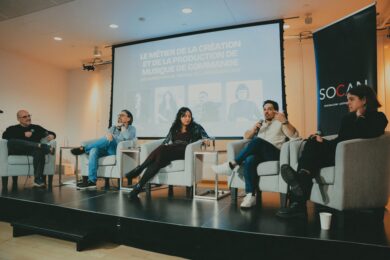On Nov. 14, 2025, the PHI Centre was vibrant with the energy of the second edition of Montréal à l’image, which has already established itself as a must-attend event for screen composers and other professionals in the field. Building on the success of its inaugural edition, the format was expanded: the morning was devoted entirely to students, while the afternoon remained focused on industry professionals. This dual approach underscored a strong commitment to nurturing emerging talent and fostering excellence in the field.
A Morning Devoted to Emerging Talent
The event was hosted by SOCAN’s Editor of the Paroles & Musique online magazine and Francophone Communications Manager Eric Parazelli, and opened with remarks from Alexandre Alonso, SOCAN’s Executive Director of Québec Affairs. He was followed by veteran composer and SPACQ-AE Board member Michel Corriveau, who shared his enthusiasm for this expanded edition.
The first segment was presented by Gautier Villette, Member Services Lead at SPACQ-AE. He reminded the audience that the Société professionnelle des auteurs, compositeurs du Québec et des artistes entrepreneurs plays a vital role in the lives of screen composers by advocating for their rights, facilitating networking among peers, offering mediation services, and providing personalized support. He outlined the range of services available, the tangible benefits of membership, and how SPACQ-AE helps foster a strong and connected creative community.
Next, Gaby Gauthier-Durand, SOCAN’s Creative Executive for Québec, took the floor for a “SOCAN 101” presentation. She explained how SOCAN operates, and its role in supporting screen composers, breaking down revenue streams, collective rights management, and the various ways SOCAN helps composers grow their careers in Québec.
Case Studies: Diving Into the Creative Process
 After a short break, the event continued with a highly practical panel, featuring three seasoned composers – Stéphanie Hamelin Tomala, Philippe Brault, and Michel Corriveau. In turn, they shared not only their insights and perspectives, but also excerpts from their work to illustrate their unique creative approaches.
After a short break, the event continued with a highly practical panel, featuring three seasoned composers – Stéphanie Hamelin Tomala, Philippe Brault, and Michel Corriveau. In turn, they shared not only their insights and perspectives, but also excerpts from their work to illustrate their unique creative approaches.
Michel Corriveau went first, and discussed his long-standing collaboration with director Charles-Olivier Michaud, particularly on the film RU. He provided context for two excerpts, demonstrating how the music evolved in close symbiosis with the editing and sound design. He explained how ongoing dialogue with the sound design team profoundly enriched the composition.
Philippe Brault, for his part, spoke about his work on the series Qui a poussé Mélodie?, a quirky mystery set in a daycare. He shared how composing the music ahead of filming helped shape the atmosphere on set, providing a creative boost for the actors.
Stéphanie Hamelin Tomala shared her experience working on Christian De La Cortina’s documentary Mon ami Omar, la bataille d’un travailleur saisonnier. She talked about her initial conversations with the director, how she carefully struck a balance where the music supports the reality without overpowering it, and proceeded to present two excerpts. She also explained why she chose to submit several tracks before the editing phase, allowing the director to use her original compositions instead of generic cues as temp music, a choice she believes helped elevate original creation.
Q&A and Mentorship
A 30-minute Q&A session followed, and audience members asked very pointed questions to the panellists. Wrapping up the morning was a 30-minute mentorship and networking session that gave students the opportunity to meet with five seasoned mentors: Anaïs Larocque, Pilou (Pierre-Philippe Côté), Briga (Brigitte Dajczer), Jérémie Corriveau, and Samuel Laflamme. The activity provided an informal yet valuable space to ask questions, seek advice, and make meaningful industry connections.
An Afternoon Focused on Working Conditions and Compensation
The afternoon session brought together professionals for a packed program. After opening remarks from SOCAN CEO Jennifer Brown, Marc Ouellette, SOCAN’s Chairman of the Board, President, and a screen composer himself, shared his perspective on the evolution of the field, and the significance of this annual gathering.
Pascal Genêt, from the Observatoire de la culture et des communications du Québec, offered valuable context with key data points on screen production, content consumption, and audience behaviour. His data-driven snapshot provided insight into the landscape in which screen composers work today, and how these realities can help inform both artistic and professional decisions.
Round Table on Working Conditions and Compensation
 A four-person panel featuring screen composers Stéphanie Hamelin Tomala, Maxime Fortin, and Marc Ouellette, along with entertainment and intellectual property lawyer Gabriella Rozankovic, took the stage to discuss key labour issues in commissioned music. Topics included the historical evolution of working conditions in Québec compared to other territories; the challenges of negotiating agreements, and finding the right balance between upfront fees and broadcast royalties; and the core issues involved in contract negotiations.
A four-person panel featuring screen composers Stéphanie Hamelin Tomala, Maxime Fortin, and Marc Ouellette, along with entertainment and intellectual property lawyer Gabriella Rozankovic, took the stage to discuss key labour issues in commissioned music. Topics included the historical evolution of working conditions in Québec compared to other territories; the challenges of negotiating agreements, and finding the right balance between upfront fees and broadcast royalties; and the core issues involved in contract negotiations.
The discussion was both pragmatic and inspiring, and the panellists emphasized the importance of collaboration, transparency, and unity among creators to strengthen their negotiating positions.
SPACQ-AE in Action, SOCAN Explains
Gautier Villette and Maxime Fortin then presented a promising new initiative: a data collection project on fee structures in commissioned music contracts. Their goal? To document current realities, identify discrepancies, and propose ways to ensure fairer conditions for screen composers. This analytical and advocacy-driven initiative was very well received.
Mike Rocha, Director for Film & TV in SOCAN’s Member Services department, delivered a presentation, AV Royalty paths: a presentation of different revenue streams from collection to distribution. He explained the revenue stream – from licensing, to usage, distribution, and finally payment – and how composers can optimize their earnings by better understanding the complex mechanics of collective rights administration.
In-Depth Interview: Cristobal Tapia de Veer
 The highlight of the afternoon was undoubtedly the 45-minute conversation with internationally acclaimed, Québec-based composer Cristobal Tapia de Veer, winner of a BAFTA, Emmy, and multiple SOCAN Awards. Conducted by Eric Parazelli, the interview explored Cristobal’s remarkable journey – from arriving in Québec as a refugee, to transitioning from classical percussion to electro-pop, and eventually, to composing for film and television.
The highlight of the afternoon was undoubtedly the 45-minute conversation with internationally acclaimed, Québec-based composer Cristobal Tapia de Veer, winner of a BAFTA, Emmy, and multiple SOCAN Awards. Conducted by Eric Parazelli, the interview explored Cristobal’s remarkable journey – from arriving in Québec as a refugee, to transitioning from classical percussion to electro-pop, and eventually, to composing for film and television.
He spoke about his contributions to major productions like Utopia, The White Lotus, and Humans; his bold and distinctive musical signature; and his creative space in the Laurentians, North of Montréal. He described how he incorporates technological glitches and the human voice into his compositions, and reflected on the courage it takes to remain independent – sometimes turning down high-profile projects to protect his artistic freedom. He offered candid, inspiring anecdotes to the composers in the room, touching on the sometimes turbulent collaboration with directors and producers, and emphasizing the importance of nurturing one’s unique voice.
Montréal à l’image Award Presentation
The event concluded with the presentation of the Montréal à l’image Award. Ariane Charbonneau, Executive Director of SPACQ, began by highlighting the award’s purpose and the importance of recognizing excellence and dedication within the screen composing community. The name of the recipient was then revealed, following a heartfelt tribute by Anaïs Larocque, ambassador of the award, and Jérémie Corriveau – composer and son of the honouree, Michel Corriveau. The elder Corriveau delivered a sincere and moving acceptance speech, before inviting everyone to continue the conversation during a networking cocktail reception.
“Receiving this kind of recognition from my peers is incredibly moving and motivating,” said Michel Corriveau. “I’m both grateful and proud to be part of this community. When I found out I had been chosen, I immediately thought of director and dear friend Erik Canuel, who gave me my first break in film, and who sadly left us far too soon. A heartfelt thank you to our fellow composer Anaïs Larocque for creating this beautiful tradition.”
Overall, this second edition of Montréal à l’image cemented its status as an essential hub for professionals, and as a valuable platform for students aspiring to a career in screen music. The addition of the student-focused morning reinforced the sense of a supportive community, and helped foster inter-generational connections that are vital to the growth of the sector.
Maxime Fortin, composer, lecturer at the University of Sherbrooke, and SPACQ-AE board member representing screen composers, nicely summed up the second edition: “Montréal à l’image isn’t just a one-off event filled with panels and networking: it’s above all a space we created to come together, to celebrate one another, and to elevate each other as screen composers. It’s a place where we can acknowledge our shared realities, discover artistic affinities, speak openly about the challenges in our industry, and strengthen our entrepreneurial skills. All of it carried by a shared passion for a language that has the extraordinary, almost magical, power to elevate stories when words need a little help. This event could never have come to life without the vision of Anaïs Larocque and the unwavering support of SOCAN and SPACQ-AE, who once again demonstrate their commitment to local creators. The balance between practical content (case studies, mentorship), strategic insight (rates, royalties), and pure inspiration (Cristobal Tapia de Veer) made this day both educational and galvanizing.”